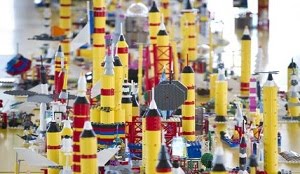What Newton had done was to find the mathematical method, the calculus to open the door to modern physics. With it he showed that the laws of falling bodies that Galileo had discovered would apply to the whole universe in such a way as to agree with Kepler's laws.
In 1664 by means of a few glass prisms and a series of simple experiments, Newton showed that white light is really a combination of colored light of the spectrum and that light travels in straight lines. From these results he invented a new type of reflecting telescope.
Robert Boyle (1627-1691) had shown the value of experiment in studying
 the physical properties of gases. After the invention of the barometer by Evangelista Toricelli, he experimented on pressure of the atmosphere. Boyle and his assistant Robert Hooke built air pump with which they were able to produce a high vacuum. With this, Boyle conducted experiments that enabled him to determine the weight of the atmosphere. Further experiments gave him the relation between the volume and pressure of a gas, and established the rule that bears his name- Boyle's law. Some of his other work, however, had caused a lack of faith in the three-element theory, and it was replaced by the phlogiston theory of Johann Joachim Becher (1635-1682). This theory held that all metals are made up of calx (dust) plus phlogiston, and when the metal is heated the phlogiston is driven off and the calx is left. By means of this theory, chemists were able to give a satisfactory explanation of many chemical facts, and it led to two things: a more detailed study of the nature of gases and their reactions with other substances, and renewed efforts to decide just what a chemical element is.
the physical properties of gases. After the invention of the barometer by Evangelista Toricelli, he experimented on pressure of the atmosphere. Boyle and his assistant Robert Hooke built air pump with which they were able to produce a high vacuum. With this, Boyle conducted experiments that enabled him to determine the weight of the atmosphere. Further experiments gave him the relation between the volume and pressure of a gas, and established the rule that bears his name- Boyle's law. Some of his other work, however, had caused a lack of faith in the three-element theory, and it was replaced by the phlogiston theory of Johann Joachim Becher (1635-1682). This theory held that all metals are made up of calx (dust) plus phlogiston, and when the metal is heated the phlogiston is driven off and the calx is left. By means of this theory, chemists were able to give a satisfactory explanation of many chemical facts, and it led to two things: a more detailed study of the nature of gases and their reactions with other substances, and renewed efforts to decide just what a chemical element is.Boyle's Air Pump:
The spherical chamber is to be exhausted of air. The bottle-shaped device below is a cylinder open at the bottom, in which a close-fitting plunger works vertically. The plunger, operated by a hand crank, pulls air down from the upper chamber. On the upstroke the air in the cylinder is let out through the down pointing system on the upper rim of the cylinder. The exhausted chamber can be sealed off by the stopcocks.
Work Cited:
www.grc.nasa.gov/WWW/K-12/airplane/aboyle.html




0 comments:
Post a Comment